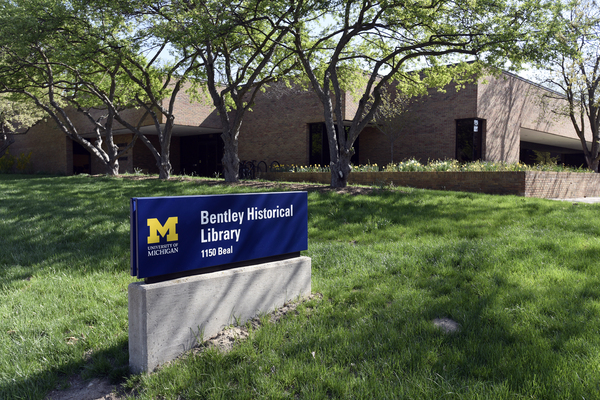
Search Constraints
Start Over You searched for: Repository University of Michigan Bentley Historical Library ✖ Remove constraint Repository: University of Michigan Bentley Historical Library Names University of Michigan. Development Council. ✖ Remove constraint Names: University of Michigan. Development Council.Search Results
3.5 linear feet
The Development Council records date from 1951 to 1985 and measure 3.5 linear feet. They are arranged in a two series: Board of Directors and an Alphabetical File. The records are most notable for organizational documents from the early 1950s and mid- to late-1960s, long runs of minutes from the board of directors (1953-1985) and steering committee (1968-1980), and correspondence from the development office (1951-1963). Surprisingly, there is a small but interesting body of records regarding fraternities and sororities, particularly Sigma Phi. This is located in the correspondence and results from the association of one of the Development Office staff with Sigma Phi.
9.0 linear feet — 1 oversize folder — 73 film reels — 26.25 GB
The papers of Harry A. Towsley provide a broad overview of the many facets of his career, including his medical education at the University of Michigan, his service with the 298th General Hospital during World War II, and his professional career as a pediatrician and educator. The collection is arranged in eleven series as follows: Biographical Material; Correspondence; Family History; Foundation Relations Committee Files; General Files; Iodine and Goiter Research; Pediatric Files; Student Notes; Reunion Files; 298th General Hospital Records; and Films.
28.5 linear feet
The Marvin Niehuss Papers document his career as Law School faculty member and university administrator. The papers include correspondence and reports concerning University affairs and some course materials from Niehuss' law classes. Included here are files relating to Niehuss' involvement in the University decision to fire three professors investigated by the House Un-American Activities Committee, and in the review of the University's compliance to the Civil Rights Act of 1964.
The Niehuss papers have arrived in three separate accessions. Researchers should be aware that there is significant overlap within the three accessions. Specific topics can be tracked across the various accessions. The papers are organized into two series: a small Miscellaneous File, 1945-1951, and Topical Files, 1923-1972.
51 linear feet (in 54 boxes) — 10.1 GB
Records of the Michigan Memorial Phoenix Project were received in three major accessions and from three major donors: National Executive Chairman Chester Lang, 1958; Assistant Director Leonard Greenbaum, 1972; and Michigan Memorial Phoenix Project, 2000. In addition, one item, a copy of the Phoenix Project logo, was received from Jacqueline Kolle Haring in 2001. The material is described as two accessions and is primarily comprised of records related to fund-raising, research, and administrative functions. Series include files documenting the history of the project, prospects, donors, research grants, and outreach. Researchers tracking a particular topic should note that there is significant overlap between accessions.
The records of the first two accessions measure three linear feet and date from 1947 to 1959. They are primarily comprised of correspondence, speeches, minutes, financial reports, and research files and are arranged into four series: Chester Lang/National Executive Chairman Files; Fund-raising Campaign; Financial Reports; and Early Research.
The records accessioned between 2000 and 2001 range from 1948 to 1997 and add 46 feet of valuable and significant documentation to the Michigan Memorial Phoenix Project record group. While large portions of the records relate to development and fund-raising aspects of the project, there are also important correspondence, research, and committee files. In addition, the accession includes a rich group of materials documenting the history of the project, as well as files regarding the national and international involvement of Phoenix administrators and scientists in the nuclear energy field.
The records are organized into the following series: History; Minutes of Meetings; Development Topical Files; Director's Topical Files; Ford Reactor; Organizations; Prospects; Donors; Research; and Audio Materials. It is important to note that since the years covered in the development topical files and director topical files series overlap, the researcher is advised to examine both runs for material on a given subject.
Michigan Memorial Phoenix Project records, 1947-2003 (majority within 1950-1980)
51 linear feet (in 54 boxes) — 10.1 GB
4 linear feet — 3 oversize volumes
The Stone collection is arranged into the following series: Correspondence; Speeches and Articles; Subject Files; and Clipping and Scrapbooks.
54 linear feet
The records of the Vice President for Development date from 1948 to the present and measure 39.5 linear feet. They reflect the basic concerns of the office for these four decades: preserving and improving the university's public image and planning major fundraising efforts. Unfortunately, both activities are incompletely documented. In the area of public relations the records tend to discuss how immediate problems will be dealt with, rather than overall conceptions of the university's image. The thought behind the innovative fundraising devices created or employed by the office is sometimes recorded through consultant reports, but in general is not well documented.
The manuscript records have been divided into two subgroups, one representing the records of the vice president (or senior staff person, for those years in which there was no vice presidency), the other containing records created by the development office. The Vice Presidents subgroup has been divided by the name of each person who has held the office: Arthur Brandon, Lyle Nelson, and Michael Radock. Researchers should note that since Nelson and Radock used their predecessor's files for some time before inaugurating their own records, the relationship between office tenure and file dates is not an exact one. The Development Office subgroup contains records of that office and its subsidiary units. Several accessions of Development Office records received in 1989 and 1990 have been grouped together as Development Office subgroup: 1989-1990 accessions.